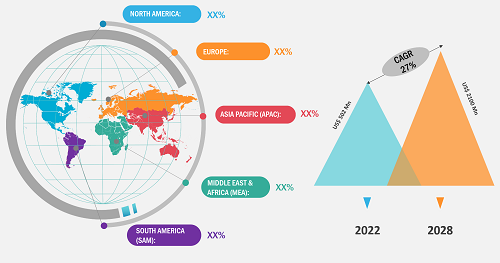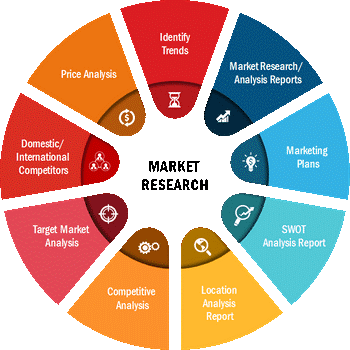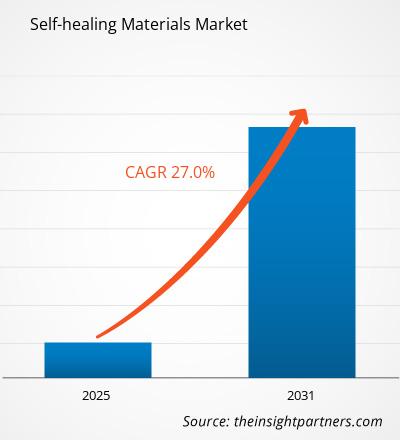Il mercato dei materiali autoriparanti è stato valutato a 435 milioni di dollari nel 2021, si prevede che crescere a un CAGR del 27% tra il 2022 e il 2031
I materiali autoriparanti possono recuperare parzialmente o completamente il danno durante l'uso operativo o con stimoli esterni come luce e temperatura ma senza intervento umano. Questo materiale è costituito da polimeri, metalli, ceramiche e loro compositi. Sono preferibili materiali autoriparanti per prevenire frequenti crepe o danni che potrebbero deteriorarsi nel tempo e compromettere l'efficienza del sistema. Inoltre, i materiali autoriparanti aumentano la durata dei componenti e possono contribuire a risparmiare sui costi aggiuntivi. La crescente preferenza per i materiali autoriparanti dovuta alle normative relative alla garanzia di servizio più lunga dei prodotti ha rafforzato il mercato.
DINAMICHE DEL MERCATO
C'è una crescente domanda di materiali autoriparanti per scopi di sicurezza nei settori dell'edilizia, dell'elettronica, militare, automobilistico e dei prodotti di consumo. Anche la crescente urbanizzazione, con conseguente aumento delle infrastrutture, sta contribuendo in modo significativo alla crescita del settore dei materiali autoriparanti. Inoltre, la preferenza per materiali durevoli per risparmiare sui costi di manutenzione spinge la crescita del mercato. Insieme a queste, opportunità redditizie grazie agli ingenti investimenti in ricerca e sviluppo aggiungono slancio alla crescita del settore dei materiali autoriparanti. Tuttavia, i prodotti ad alto prezzo limitano il mercato dei materiali autoriparanti crescita.
AMBITO DI MERCATO
L'"Analisi del mercato globale dei materiali autoriparanti fino al 2031" è un'analisi studio specializzato e approfondito con particolare attenzione all’analisi delle tendenze del mercato globale. L’obiettivo del rapporto è fornire una panoramica del mercato con una segmentazione dettagliata del mercato per tipo, forma e utilizzo finale. Il rapporto fornisce statistiche chiave sullo stato del mercato del principale attore di mercato dei materiali autoriparanti e offre tendenze e opportunità chiave nel settore dei materiali autoriparanti.
Approfondimenti strategici
SEGMENTAZIONE DEL MERCATO
Il mercato globale dei materiali autoriparanti è segmentato in base al tipo, alla forma e all'uso finale. In base alla tipologia, il mercato è segmentato in polimeri, compositi, ceramica, calcestruzzo , e altri. In base alla forma, il mercato è biforcato in estrinseco e intrinseco. In termini di utilizzo finale, il mercato è classificato in sanità, automobilistico e trasporti, elettrico ed elettronico, edilizia e costruzioni e altri.
Il rapporto fornisce una panoramica dettagliata del settore, comprese informazioni sia qualitative che quantitative. Fornisce una panoramica e previsioni del mercato globale dei materiali autoriparanti in base a vari segmenti. Fornisce inoltre stime sulle dimensioni del mercato e sulle previsioni dal 2021 al 2031 rispetto a cinque regioni principali: Nord America, Europa, Asia Pacifico (APAC), Medio Oriente e Asia. Africa (MEA) e Sud America. Il mercato dei materiali autoriparanti per ciascuna regione viene successivamente suddiviso in sottosegmenti dai rispettivi paesi. Il rapporto copre l'analisi e le previsioni di 18 paesi a livello globale insieme alle tendenze attuali e alle opportunità prevalenti nella regione.
Dal punto di vista regionale, l'Asia del Pacifico domina il mercato dei materiali autoriparanti nel 2021. Il predominio dell'Asia del Pacifico nel mercato è dovuto principalmente all'elevato tasso di adozione di materiali autoriparanti dall'edilizia, dal settore automobilistico , elettronica, ecc. Alcuni dei principali produttori di materiali autoriparanti nella regione includono Acciona SA; AkzoNobel NV; Film sottili applicati, Inc.; Arkema SA; e Autonomic Materials Inc. Questi fornitori testimoniano una domanda costante da parte delle industrie di utilizzo finale. La figura seguente mostra il trend di crescita dei ricavi nel mercato dei materiali autoriparanti:
 Fonte: analisi dei partner Insight
Fonte: analisi dei partner Insight
Il rapporto analizza i fattori che influenzano il mercato dei materiali autoriparanti da entrambi dal lato della domanda e dell'offerta e valuta ulteriormente le dinamiche del mercato, ovvero i fattori trainanti, le restrizioni, le opportunità e le tendenze future, che influiscono sul mercato durante il periodo di previsione. Il rapporto fornisce anche un'analisi esaustiva delle cinque forze di Porter evidenziando i fattori che influenzano il mercato dei materiali autoriparanti.
IMPATTO DELLA PANDEMIA DA COVID-19
A causa della pandemia di COVID-19, molti settori, come quello chimico & materiali e costruzioni, hanno dovuto affrontare sfide senza precedenti a causa di interruzioni nella catena di approvvigionamento globale che hanno influito negativamente sulla produzione, sui programmi di consegna e sulle vendite di vari beni. La dimensione del mercato dei materiali autoriparanti è diminuita a causa del calo della crescita di diversi settori industriali. Molti siti di produzione sono stati parzialmente o completamente chiusi per contrastare la diffusione del SARS-CoV-2. La pandemia di COVID-19 ha causato fluttuazioni anche nei prezzi dei materiali autoriparanti.
Tuttavia, dal 2021, l'industria automobilistica e delle costruzioni sono in forte crescita e si prevede che il trend di crescita continui nel corso degli anni. Ciò stimolerebbe il consumo di materiali autoriparanti, rafforzando così probabilmente il mercato durante il periodo di previsione.
ATTORI DEL MERCATO
I rapporti riguardano le principali strategie di crescita organica e inorganica nel mercato dei materiali autorigeneranti. Diverse aziende si stanno concentrando su strategie di crescita organica come lanci di prodotti, approvazioni di prodotti e altri come brevetti ed eventi. Le attività delle strategie di crescita inorganica testimoniate nel mercato sono state acquisizioni e partnership & collaborazioni. Queste attività hanno aperto la strada all’espansione del business e della base clienti degli operatori del mercato. Si prevede che gli operatori del mercato dei materiali autoriparanti assisteranno a opportunità di crescita redditizie in futuro con la crescente domanda di materiali autoriparanti.
Il rapporto include anche i profili delle principali società del mercato dei materiali autoriparanti lungo con la loro analisi SWOT e strategie di mercato. Inoltre, il rapporto si concentra sui principali attori del settore con informazioni quali profili aziendali, componenti e servizi offerti, informazioni finanziarie degli ultimi 3 anni e sviluppi chiave negli ultimi cinque anni. Di seguito è riportato l'elenco di alcune aziende impegnate nel mercato dei materiali autoriparanti.
- Acciona SA
- AkzoNobel NV
- Applied Thin Films, Inc .
- Arkema SA
- Autonomic Materials Inc.
- Avecom NV
- BASF SE
- Covestro AG
- Critical Materials SA
- Devan Chemicals
Il team di ricerca e analisi dedicato del partner Insight è composto da professionisti esperti con competenze statistiche avanzate e offre varie opzioni di personalizzazione nello studio esistente.

- Analisi storica (2 anni), anno base, previsione (7 anni) con CAGR
- Analisi PEST e SWOT
- Valore/volume delle dimensioni del mercato - Globale, regionale, nazionale
- Industria e panorama competitivo
- Set di dati Excel



Report Coverage
Revenue forecast, Company Analysis, Industry landscape, Growth factors, and Trends

Segment Covered
This text is related
to segments covered.

Regional Scope
North America, Europe, Asia Pacific, Middle East & Africa, South & Central America

Country Scope
This text is related
to country scope.
Trends and growth analysis reports related to Chemicals and Materials : READ MORE..
The List of Companies
1. Acciona, S.A.
2. Akzo Nobel N.V.
3. Apple Inc.
4. Autonomic Materials, Inc.
5. BASF SE
6. Bayer AG
7. MacDermid Autotype Ltd.
8. Michelin North America Inc.
9. NEI Corporation
10. SMP Technologies Inc.
The Insight Partners performs research in 4 major stages: Data Collection & Secondary Research, Primary Research, Data Analysis and Data Triangulation & Final Review.
- Data Collection and Secondary Research:
As a market research and consulting firm operating from a decade, we have published and advised several client across the globe. First step for any study will start with an assessment of currently available data and insights from existing reports. Further, historical and current market information is collected from Investor Presentations, Annual Reports, SEC Filings, etc., and other information related to company’s performance and market positioning are gathered from Paid Databases (Factiva, Hoovers, and Reuters) and various other publications available in public domain.
Several associations trade associates, technical forums, institutes, societies and organization are accessed to gain technical as well as market related insights through their publications such as research papers, blogs and press releases related to the studies are referred to get cues about the market. Further, white papers, journals, magazines, and other news articles published in last 3 years are scrutinized and analyzed to understand the current market trends.
- Primary Research:
The primarily interview analysis comprise of data obtained from industry participants interview and answers to survey questions gathered by in-house primary team.
For primary research, interviews are conducted with industry experts/CEOs/Marketing Managers/VPs/Subject Matter Experts from both demand and supply side to get a 360-degree view of the market. The primary team conducts several interviews based on the complexity of the markets to understand the various market trends and dynamics which makes research more credible and precise.
A typical research interview fulfils the following functions:
- Provides first-hand information on the market size, market trends, growth trends, competitive landscape, and outlook
- Validates and strengthens in-house secondary research findings
- Develops the analysis team’s expertise and market understanding
Primary research involves email interactions and telephone interviews for each market, category, segment, and sub-segment across geographies. The participants who typically take part in such a process include, but are not limited to:
- Industry participants: VPs, business development managers, market intelligence managers and national sales managers
- Outside experts: Valuation experts, research analysts and key opinion leaders specializing in the electronics and semiconductor industry.
Below is the breakup of our primary respondents by company, designation, and region:

Once we receive the confirmation from primary research sources or primary respondents, we finalize the base year market estimation and forecast the data as per the macroeconomic and microeconomic factors assessed during data collection.
- Data Analysis:
Once data is validated through both secondary as well as primary respondents, we finalize the market estimations by hypothesis formulation and factor analysis at regional and country level.
- Macro-Economic Factor Analysis:
We analyse macroeconomic indicators such the gross domestic product (GDP), increase in the demand for goods and services across industries, technological advancement, regional economic growth, governmental policies, the influence of COVID-19, PEST analysis, and other aspects. This analysis aids in setting benchmarks for various nations/regions and approximating market splits. Additionally, the general trend of the aforementioned components aid in determining the market's development possibilities.
- Country Level Data:
Various factors that are especially aligned to the country are taken into account to determine the market size for a certain area and country, including the presence of vendors, such as headquarters and offices, the country's GDP, demand patterns, and industry growth. To comprehend the market dynamics for the nation, a number of growth variables, inhibitors, application areas, and current market trends are researched. The aforementioned elements aid in determining the country's overall market's growth potential.
- Company Profile:
The “Table of Contents” is formulated by listing and analyzing more than 25 - 30 companies operating in the market ecosystem across geographies. However, we profile only 10 companies as a standard practice in our syndicate reports. These 10 companies comprise leading, emerging, and regional players. Nonetheless, our analysis is not restricted to the 10 listed companies, we also analyze other companies present in the market to develop a holistic view and understand the prevailing trends. The “Company Profiles” section in the report covers key facts, business description, products & services, financial information, SWOT analysis, and key developments. The financial information presented is extracted from the annual reports and official documents of the publicly listed companies. Upon collecting the information for the sections of respective companies, we verify them via various primary sources and then compile the data in respective company profiles. The company level information helps us in deriving the base number as well as in forecasting the market size.
- Developing Base Number:
Aggregation of sales statistics (2020-2022) and macro-economic factor, and other secondary and primary research insights are utilized to arrive at base number and related market shares for 2022. The data gaps are identified in this step and relevant market data is analyzed, collected from paid primary interviews or databases. On finalizing the base year market size, forecasts are developed on the basis of macro-economic, industry and market growth factors and company level analysis.
- Data Triangulation and Final Review:
The market findings and base year market size calculations are validated from supply as well as demand side. Demand side validations are based on macro-economic factor analysis and benchmarks for respective regions and countries. In case of supply side validations, revenues of major companies are estimated (in case not available) based on industry benchmark, approximate number of employees, product portfolio, and primary interviews revenues are gathered. Further revenue from target product/service segment is assessed to avoid overshooting of market statistics. In case of heavy deviations between supply and demand side values, all thes steps are repeated to achieve synchronization.
We follow an iterative model, wherein we share our research findings with Subject Matter Experts (SME’s) and Key Opinion Leaders (KOLs) until consensus view of the market is not formulated – this model negates any drastic deviation in the opinions of experts. Only validated and universally acceptable research findings are quoted in our reports.
We have important check points that we use to validate our research findings – which we call – data triangulation, where we validate the information, we generate from secondary sources with primary interviews and then we re-validate with our internal data bases and Subject matter experts. This comprehensive model enables us to deliver high quality, reliable data in shortest possible time.

 Ottieni un campione gratuito per questo repot
Ottieni un campione gratuito per questo repot